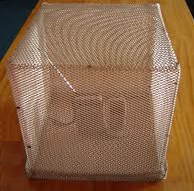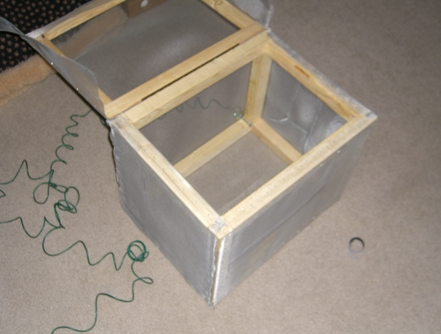HOW TO BUILD A FARADAY CAGE
What is a Faraday Cage? In a nutshell, a Faraday Cage is s container that protects sensitive
electronics from an Electromagnetic pulse generated from a nuclear detonation high in the
atmosphere, or from a massive solar flare. A massive EMP will render anything that uses
chips, resistors etc. (basically all electronics) useless ... forever. (They will be "fried".) This
article will instruct you on How To Build A Faraday Cage (cheaply) that will protect your
valuable electronics and batteries.
A simplistic explanation of the construction of a Faraday Cage is: any metal box, or cage (it
doesn't have to be solid) that completely surrounds the contents with a "metal
shield"(including the top and the bottom) metal. The EMP will pass over and around the
Faraday Cage rather than through it, thus protecting any electronic (and batteries) that have
been placed inside the cage. Your microwave oven is actually a Faraday Cage. If you look
closely at the glass door, you'll see a mesh embedded within the glass. That same mesh is
also between the inner and outer skin. If there was no metal mesh, the microwaves would
burn your face when you peeked into the oven to see if your burrito was done.
You can spend a kings ransom for a custom built Faraday Cage, but it's absolutely not
necessary.
Below are 2 examples of EMP cages, or faraday cages. They are easy and inexpensive to
make and protecting your electronics will put you in the minority when and if the power
grid comes back to life.
The one made with the screen is closest to what I built. Mine is much larger and I started
with 1" x 1" spaced x 1/8" thick steel mesh then used the screen to cover everything. The
inside has 1" x 1" pine boards creating an inner framework then covered by thin plyboard to
offset the inner walls, floor and cieling by 1 inch.
I used 6 feet of standard guage battery cable (black) with the insulation cut back off the
copper inner wire 2 full inches. I seperated the inner copper wire so it was kinda flat then
layed it over the 1/8" thick steel mesh (cage) and soldered it in place. The other end will be
attached by a cable clamp to a six foot ground rod that will be buried 5' 6" inches deep.
It sits on a platform made of 2" x 4" boards. It is also covered with a heavy duty cardboard
box just to keep dust and debris from getting to the contents.
Your list of things you want to protect will give you your first idea of how big you need to
make your cage. If you have anything solar, your panels, charge controllers and anything
electronic will need to be protected. Cell phones would be the last thing you'd want to
protect as cell towers will be impossible to protect from an EMP, either from the sun or a
aerial nuclear blast.


The most important thing is to cover sides, top and bottom and to ground this box to the
earth. It can be a solid box with a lid but the lid, when closed must be in full and constant
contact (all sides) with the bottom section. Any areas that do not have a good contact will
allow the pulse to leak in and could destroy the contents. The grounding is critical as the
pulse being absorbed by the cage needs to be bled off to ground (earth) and the larger the
ground wire used the better the transfer of this pulse current is to ground.
There are plenty of examples online which give you many options of size and materials.
Just pay close attention to the details and adhere to these details when making your own
cage. See any "warnings" or "notes"? READ THOSE CAREFULLY, they could be very
important to the effectiveness of your cage and maybe keep you from injuring yourself.
What is a Faraday Cage? In a nutshell, a Faraday Cage is s container that protects sensitive
electronics from an Electromagnetic pulse generated from a nuclear detonation high in the
atmosphere, or from a massive solar flare. A massive EMP will render anything that uses
chips, resistors etc. (basically all electronics) useless ... forever. (They will be "fried".) This
article will instruct you on How To Build A Faraday Cage (cheaply) that will protect your
valuable electronics and batteries.
A simplistic explanation of the construction of a Faraday Cage is: any metal box, or cage (it
doesn't have to be solid) that completely surrounds the contents with a "metal
shield"(including the top and the bottom) metal. The EMP will pass over and around the
Faraday Cage rather than through it, thus protecting any electronic (and batteries) that have
been placed inside the cage. Your microwave oven is actually a Faraday Cage. If you look
closely at the glass door, you'll see a mesh embedded within the glass. That same mesh is
also between the inner and outer skin. If there was no metal mesh, the microwaves would
burn your face when you peeked into the oven to see if your burrito was done.
You can spend a kings ransom for a custom built Faraday Cage, but it's absolutely not
necessary.
Below are 2 examples of EMP cages, or faraday cages. They are easy and inexpensive to
make and protecting your electronics will put you in the minority when and if the power
grid comes back to life.
The one made with the screen is closest to what I built. Mine is much larger and I started
with 1" x 1" spaced x 1/8" thick steel mesh then used the screen to cover everything. The
inside has 1" x 1" pine boards creating an inner framework then covered by thin plyboard to
offset the inner walls, floor and cieling by 1 inch.
I used 6 feet of standard guage battery cable (black) with the insulation cut back off the
copper inner wire 2 full inches. I seperated the inner copper wire so it was kinda flat then
layed it over the 1/8" thick steel mesh (cage) and soldered it in place. The other end will be
attached by a cable clamp to a six foot ground rod that will be buried 5' 6" inches deep.
It sits on a platform made of 2" x 4" boards. It is also covered with a heavy duty cardboard
box just to keep dust and debris from getting to the contents.
Your list of things you want to protect will give you your first idea of how big you need to
make your cage. If you have anything solar, your panels, charge controllers and anything
electronic will need to be protected. Cell phones would be the last thing you'd want to
protect as cell towers will be impossible to protect from an EMP, either from the sun or a
aerial nuclear blast.


The most important thing is to cover sides, top and bottom and to ground this box to the
earth. It can be a solid box with a lid but the lid, when closed must be in full and constant
contact (all sides) with the bottom section. Any areas that do not have a good contact will
allow the pulse to leak in and could destroy the contents. The grounding is critical as the
pulse being absorbed by the cage needs to be bled off to ground (earth) and the larger the
ground wire used the better the transfer of this pulse current is to ground.
There are plenty of examples online which give you many options of size and materials.
Just pay close attention to the details and adhere to these details when making your own
cage. See any "warnings" or "notes"? READ THOSE CAREFULLY, they could be very
important to the effectiveness of your cage and maybe keep you from injuring yourself.

















































